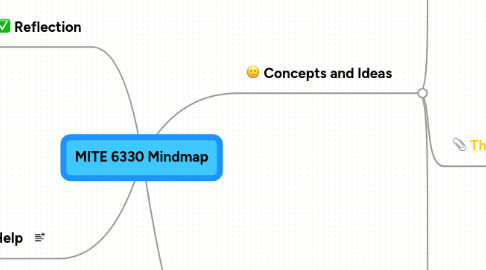
1. Reflection
1.1. Google Document
2. Help
2.1. Links to the reading materials
2.2. Methodology used in research
2.3. Definition in detail within the notes
2.4. Pictures to explain the theory/principle
2.5. Important Concepts for my perspectives
2.6. Important events during the development
2.7. Deficiencies
3. Concepts and Ideas
3.1. Instructional Design
3.1.1. ID Development
3.1.1.1. History
3.1.1.1.1. Instructional Media
3.1.1.1.2. Instructional Design
3.1.1.2. ID1
3.1.1.2.1. ISD
3.1.1.2.2. Component Display Theory
3.1.1.2.3. Limitations
3.1.1.3. ID2
3.1.1.3.1. Components
3.1.1.3.2. Address the shortcomings
3.1.2. In Teaching and Learning
3.1.2.1. Settings
3.1.2.1.1. Course
3.1.2.1.2. Media
3.1.2.2. Teacher
3.1.2.2.1. Teachers' private theories
3.1.2.2.2. Expert Teacher's Thinking and Teaching and Instructional Design Models and Principles
3.1.2.3. Learning
3.1.2.3.1. The 4C/ID-Model for Complex Learning
3.1.2.3.2. Learning by Doing
3.2. Theories and Models
3.2.1. Models
3.2.1.1. PBL
3.2.1.1.1. Problem Solving
3.2.1.1.2. Central Principles
3.2.1.1.3. Instructional Principles
3.2.1.1.4. Best Exemplars - PBL
3.2.1.1.5. Comparision
3.2.1.2. REALs
3.2.1.3. RBL
3.2.1.3.1. Predigital Age
3.2.1.3.2. Digital Age
3.2.2. Theories
3.2.2.1. Activity Theory
3.2.2.1.1. Activity System
3.2.2.1.2. Assumptions of activity theory
3.2.2.2. Learning Theory
3.2.2.2.1. Behaviorism
3.2.2.2.2. Cognitivism
3.2.2.2.3. Constructivism
3.2.2.3. Cognitive Flexibility Theory
3.3. Technology
3.3.1. Web 2.0
3.3.1.1. Features
3.3.1.1.1. A paradigm shift
3.3.1.1.2. Users-Creation of new information
3.3.1.1.3. Provide powerful media production
3.3.1.1.4. Social networking technologies
3.3.1.1.5. Rich user experiences
3.3.1.1.6. support collective activities
3.3.1.2. In education
3.3.1.2.1. New forms of assessment such as digital portfolios
3.3.1.2.2. Use of Internet-mediated social learning spaces
3.3.1.2.3. New forms of collaborative learning
3.3.1.2.4. New models and methods for the design of learning objects
3.3.1.2.5. New models for resources sharing and support for technology integration of communities of teachers
3.3.1.2.6. New generations of learning management systems (LMS)
3.3.2. Handheld devices
3.3.2.1. Technology - Pedagogy
3.3.2.1.1. Others
3.3.2.1.2. Data Collection - Contextual/Constructivist
3.3.2.1.3. Location Aware - Contextual/Constructivist
3.3.2.1.4. Collaborative - Collaborative/Contextual/Constructivist
3.3.2.2. Example applications
3.3.2.2.1. TxtIT
3.3.2.2.2. SortIT
